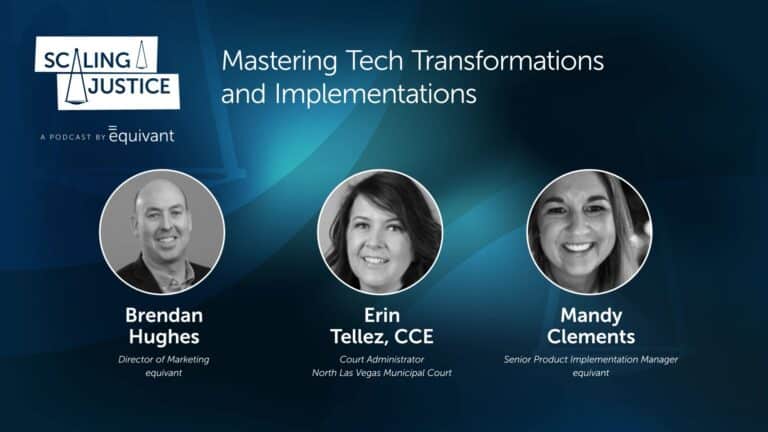In an era where technology is transforming every aspect of our lives, courts have a unique opportunity and responsibility to evolve in ways that foster trust, transparency, and accessibility. Building a better and more accessible court experience doesn’t mean compromising professionalism or efficiency. It means designing systems and interactions that reflect empathy, respect, and understanding, which positively impacts communities and constituents.
Here are nine powerful ways your court can make justice more accessible.
1. Address Barriers to Appearing in Court
Many people miss court simply because getting there is too difficult. Courts can easily take steps to remove those barriers by offering several services. For example, courts could offer on-site childcare and work with local policymakers to make sure public transportation is readily available to and from the courthouse.
It’s important to determine what barriers are facing your constituents. By working closely with community leaders to understand and resolve these challenges, courts can make it easier for people to show up, participate, and engage meaningfully in the justice process.
2. Speak the Language of the People You Serve
Legal jargon can be intimidating. Replace complex terminology with plain language wherever possible, including on your website, in forms, and during in-person interactions. Use clear, concise explanations and offer translations for non-English speakers. When people understand what’s happening, they feel empowered and respected.
Pro tip: Test your communications with real users. If a high school student can’t understand it, it’s time to simplify.
3. Prioritize Clear, Common-Sense Processes
Reassessing outdated procedures can be challenging, but it’s essential, especially for individuals who interact with the court system only once. While attorneys and frequent users can adapt to the most complex workflows, community members handling a one-time issue without legal representation may struggle if the process is confusing or overly complicated. Streamlining these systems not only improves access to justice but also builds trust and confidence in the institution.
4. Make Your Website a Welcoming Front Door
Your website is often the first point of contact. Make it feel like a helpful guide, not a bureaucratic maze. Use intuitive navigation, mobile-friendly design, and accessible content. Include FAQs, step-by-step guides, and live chat or chatbot support to help users find what they need quickly.
Put all your plain-language and easy-to-use content online and revisit it often. Court websites should never be one-and-done. Look for ways to simplify, clarify, streamline, and update content, and always seek feedback on how to make your site more user-friendly.
Bonus: Feature real stories or testimonials from court users to build relatability and trust.
5. Expand Access with Online Dispute Resolution Tools
Just as banks have shifted many services online, courts can use technology to meet people where they are. Offering digital options allows individuals to resolve disputes, handle traffic violations, and manage other routine matters without needing to appear in person. Many citizens prefer the flexibility of remote interactions with the court system, especially those with limited time, transportation, or mobility. By providing online dispute resolution tools, courts empower users to choose the method that best fits their needs.
6. Train Staff to Lead with Empathy
Every interaction—whether at the front desk, on the phone, or in the courtroom—is a chance to build trust. Equip your staff with training in trauma-informed care, cultural sensitivity, and active listening. A warm greeting or a patient explanation can make a world of difference to someone navigating the justice system.
Court staff often hesitate to answer questions out of concern they might accidentally offer legal advice. To address this, provide clear training that helps staff distinguish between legal information (which they can share) and legal advice (which they cannot). When staff understand these boundaries, they gain the confidence and authority to offer meaningful assistance to the public, guaranteeing that everyone who walks through the door feels supported and knowledgeable.
Remember: Empathy is a skill that can be taught and reinforced.
7. Design Physical Spaces That Feel Safe and Respectful
The layout and atmosphere of your courthouse send a message. Is it welcoming or intimidating? Consider signage, lighting, seating, and privacy. Create spaces that are clean, calm, and easy to navigate. Even small changes, like adding children’s play areas or quiet waiting zones, can improve the experience for everyone.
Tip: Involve community members in redesign efforts to ensure their needs are met.
8. Use Technology to Empower, Not Alienate
Digital tools should make justice more accessible, not more confusing. Offer online scheduling, electronic payment options, digital document submission, and automated reminders. All of these tools support flexibility and increase court appearance rates. However, it’s essential to make sure these tools are easy to use and supported by clear instructions. Provide alternatives for those without internet access or digital literacy.
Key takeaway: Technology should meet people where they are, not leave them behind.
9. Listen, Learn, and Adapt
Making justice more accessible is an ongoing process. Create feedback loops through surveys, community forums, and user testing. Be open to criticism and willing to make changes. When people see that their voices matter, trust grows.
Action step: Regularly review feedback and share what changes you’ve made as a result.
Building the best court you can and making justice accessible is essential for building public trust and ensuring equitable access to justice. By focusing on empathy, clarity, and user-centered design, your court can become a place where people feel seen, heard, and respected. If you’re ready to build a better court, contact us.





